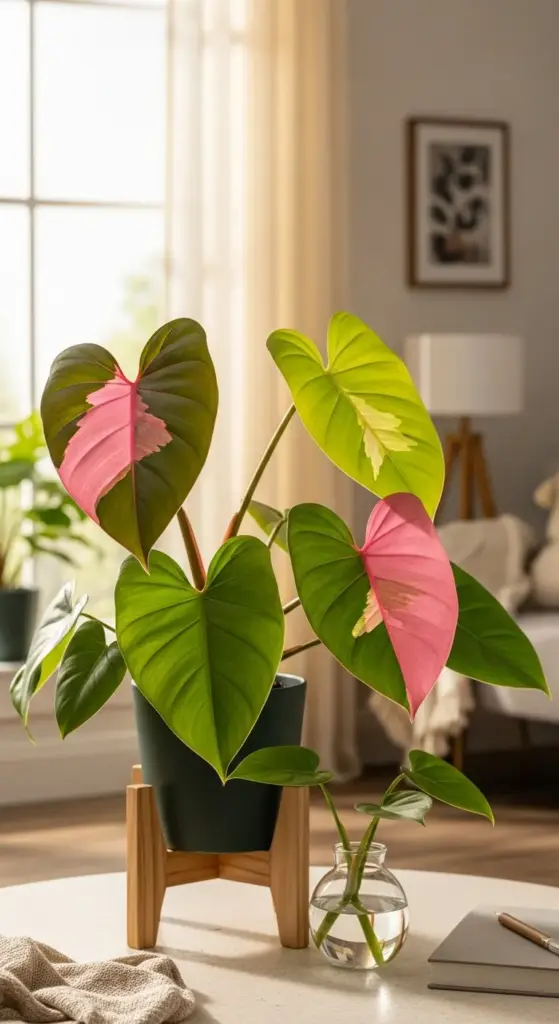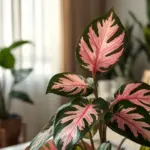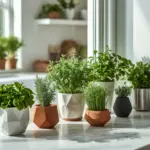5. Philodendron Pink Princess

I still remember the day I paid $180 for a three-leaf Philodendron Pink Princess cutting and immediately questioned my life choices. My partner looked at me like I’d lost my mind, and honestly, I wasn’t sure they were wrong.
That was two years ago, and now I have seven plants worth probably $2,000 total.
This plant taught me that sometimes the “crazy expensive” purchases are actually the smartest investments you can make. But only if you understand what you’re buying.
The Science Behind That Gorgeous Pink Variegation
Here’s what I wish someone had explained to me before I bought my first Pink Princess – that pink coloring isn’t guaranteed to stick around.
The variegation is actually a genetic mutation that can be incredibly unstable.
I learned this the hard way when my beautiful pink-splashed leaves started coming in solid green. I panicked, thinking I’d somehow killed the variegation, but it turns out this is totally normal.
Pink variegation happens when the plant can’t produce chlorophyll in certain areas. Too little light, and the plant prioritizes survival over pretty colors. Too much light, and the pink areas can actually burn.
The key is finding that sweet spot where the plant feels secure enough to keep producing those stunning pink sections.
I’ve noticed my plant cycles through phases – sometimes I get three pink leaves in a row, then two solid green ones. It’s like the plant is deciding how much energy it wants to spend on being gorgeous versus staying alive.
Light Management That Actually Works
Every Pink Princess care guide I read made light management sound like rocket science. After two years of trial and error, I can tell you it’s way simpler than people make it out to be.
Bright, indirect light is your best friend – but what does that actually mean in real life?
My plant sits about 3 feet from a south-facing window with a sheer curtain. It gets maybe 2-3 hours of direct morning sun, then filtered light for the rest of the day.
The pink areas are basically solar panels that don’t work – they can’t photosynthesize. So if you want to keep that variegation, the green parts need to be working overtime.
I rotate mine a quarter turn every week to make sure all sides get equal light exposure. This prevents the plant from getting lopsided and helps maintain consistent variegation.
During winter, I actually move it closer to the window since the light is weaker. Summer means pulling it back a bit to prevent those delicate pink areas from getting crispy.
Propagation Secrets That Multiply Your Investment
Okay, this is where things get really interesting from a financial perspective. Philodendron Pink Princess propagation can literally pay for your plant hobby if you do it right.
Every node with decent variegation is potentially worth $50-150 depending on the market.
I take cuttings from my mother plant twice a year – usually in spring and early summer when growth is most active. The key is making sure each cutting has at least one node and some pink variegation.
Water propagation works perfectly for this plant. I use clear glass containers so I can watch the root development, and roots usually appear within 2-3 weeks.
Here’s the secret nurseries don’t want you to know – you can actually encourage more variegation by taking cuttings from the most variegated sections of the vine.
I’ve sold enough cuttings to completely pay for my original plant plus buy two more. It’s like having a pink money tree in your living room.
Styling for Instagram-Worthy Interiors
The Pink Princess is basically the holy grail of plant styling because it works with so many different aesthetics. Those pink splashes add just enough color without being overwhelming.
In modern farmhouse settings, I pair mine with white ceramic pots and natural wood plant stands. The pink variegation adds that perfect pop of color against neutral backgrounds.
For boho-chic spaces, try macrame hangers or woven baskets. The trailing vines look gorgeous cascading down, and the pink leaves catch light beautifully.
The key is letting the plant be the star – don’t compete with busy patterns or bright colors that’ll clash with those delicate pink tones.
I’ve found that natural materials like wood, rattan, and ceramic really complement the organic pink coloring. Avoid anything too modern or industrial that might make the plant look out of place.
Avoiding Expensive Sourcing Disasters
This is where I need to save you from some costly mistakes. The Pink Princess market is absolutely flooded with scams, overpriced plants, and sellers who don’t understand what they’re selling.
Never buy a plant based on photos alone – variegation can be heavily filtered or edited to look more pink than it actually is.
Red flags to watch for: Prices that seem too good to be true, sellers with no reviews, and anyone who won’t provide multiple photos from different angles.
I’ve had the best luck with established plant collectors on Facebook groups and Instagram. These people actually know what they’re selling and usually provide detailed care histories.
Etsy can be hit or miss – I’ve gotten amazing plants and complete duds from the same platform. Always read reviews carefully and ask questions before purchasing.
Local plant swaps and specialty nurseries are goldmines if you can find them. The plants are usually healthier, and you can see exactly what you’re buying before handing over your money.
Ready to discover a plant that looks like Swiss cheese and grows like a weed? Hit “next” to learn about the Monstera Adansonii – the trailing beauty that’ll give you that jungle vibe without taking over your entire apartment!









GIPHY App Key not set. Please check settings